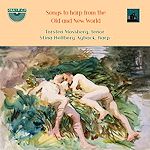A FIFTH GARLAND OF ENGLISH LIGHT MUSIC COMPOSERS
Several of the composers to be discussed here are little known nowadays though they were quite popular fifty or sixty years ago. One exception is Arthur Hutchings who died as recently as 1989, aged 83 and was probably only marginally a light music composer, being more of an academic, with books published on Schubert, Edmund Rubbra, Delius, Mozart, the Baroque Concerto and 19th Century Church Music, although many of these were aimed as much at the general reader as at the musical scholar. Hutchings was Professor at Durham University 1947-68 and at Exeter from 1968 to 1970. Not many people realise he was also a significant composer. Some of his work was for the church, settings of the Mass and the Anglican services, anthems, like Give Me The Wings of Faith, hymn tunes, St Oswald's Music (i.e. for parish communion; unison choir and congregation) and a set of Seasonal Preludes for the organ. But he wrote also for orchestra - a set of Variations and an attractively light Suite for strings - for secular choir (the cantata Heart's Desire) and for the stage. His opera after Dryden's Marriage à la Mode was helped by his great knowledge of 18th Century music; in lighter vein still was the operetta The Plumber's Arms.
Michael Mullinar and Raymond Loughborough were primarily song composers of the "superior ballad" type and while their dates are not readily to hand, both their "floreat" periods were from around 1925 to around 1955. Mullinar's dates were in fact 1895-1973. Mullinar's songs included, unfortunately, for him, several titles set by more popular figures: I Will go with My Father a-Ploughing (1951), The Smuggler's Song and To Daffodils. Others were The Daisies (1950), Cotswold Love, An Epitaph (1956), The Seas are Quiet (1947), The Vagrant, Wine and Water and the early Cider (1924). Also popular in style were the Four Old French Airs and the nursery rhymes entitled Pippen Hill. He produced a few folk-song arrangements for chorus, plus the carol In the Bleak Midwinter - again the settings by Holst and Darke are so much more popular and there is scarcely room for another. His interest in music for children was underlined by his short cantata The Princess and the Swineherd (1930) and a five movement suite for piano, Grimm Fairy Tales, plus an independent piece, Jorinda and Jorindel, on another Grimms story, dating from 1959.
Loughborough's songs, of which I have discovered a note of more than 40, covered a fair range. Their publication dates span the period 1922 (Captain Danny) to 1952 (Snowfall). Most popular were At Sundown, The Homing Ship and The Lover and The Song. A Song in the Night had a violin obbligato; it was aired by the great baritone singer Topliss Green in Doncaster in 1934. Many titles have a feel of the sea: The Tune the Bos'un Played, My Haven, Mortenhoe, The Little Ships, inspired, as were so many British composers at the time, by the Dunkirk evacuation, and the four song sequence Old Ships. Like so many others at that period he turned to making arrangements of 18th Century English songs. A few choral songs like The Farmer's Lad (AATB) appeared and the BBC Catalogue includes some orchestral works by him, though all of it, like the Jevington Suite, Passing Shadows, Sea Dreams and Summer Noon (for violin, saxophone, cornet and orchestra) is actually orchestrated by other hands: Sidney Baynes, Arthur Wood and H.M. Higgs, perhaps from piano originals in each case. Loughborough also dabbled in the light genre piece for chamber ensemble, Mirage and Song of Sunset, both for piano trio, appearing in 1927 and 1938 respectively.
Another who produced music of that type and at exactly the same period was F. Percival Driver, whose Three Little Trios of 1927 were entitled The Song of the Clock, Harvesting Time and Slumber Song. The latter has been revived in Doncaster during the past few years. Other Driver instrumental music included the Dainty Dance for violin and piano and, for piano solo, All-in-a-Ring (four movements: 1936), Four Sketches (1926) and, revealing Driver's considerable gift for pastiche, An Old Style Measure, the Three Dance Measures of 1926 (Gavotte, Saraband and Passepied) and a Little Suite (Prelude, Saraband and Gigue). A more ambitious piece for keyboard was the Variations on an Original Theme for two pianos. But few play his music now.
Two who were better known as arrangers than as composers may here share a paragraph. First of them in point of time was H.M. Higgs, who made, among other arrangements, many orchestral selections of popular songs by Eric Coates, Montague Phillips, Haydn Wood, Guy d'Hardelot and others. But there were original orchestral compositions, too, from his pen. Two of them derived inspiration, Ketèlbey-like, from the exotic climes of Japan: the "musical story" In a Japanese Garden and, a six movement suite Life in Japan. And occasionally he published vocal pieces like the partsong (SATB) Oh Say Not Women's Heart is Bought (1915) and organ pieces like Allegro and Miniature. Felton Rapley came a generation or more later. Both his arrangements and his original compositions were very numerous and very diverse. Best known of the former was Portrait of Clare, arranged, for orchestra or piano, from Schumann's song Devotion. The latter included many pieces for orchestra - the overture Down the Solent, A Highland Vision, An Irish Legend, Twilight Meditation, Evening in Capri, Elegy for Strings, String Prelude and the march Metropolis - church music (the anthem Angel Voices Ever Singing, The Lord is My Light, Though I Speak, Ye Holy Angels and If The Lord Himself) and many unison songs doubtless intended for young voices with titles like Cat!, Cradle Hymn, The Crooked Man, The Midnight Sun and The Pilgrim Song. Rapley was an accomplished performer on both piano and organ and he published solos for both instruments, those for the former included Fabiola and Lugano; examples of the later were Pastoral Improvisation and Postlude For a Joyful Occasion.
George Frederick Norton is connected in the minds of music lovers with just one work, the musical comedy Chu Chin Chow, produced at His Majesty's Theatre on 3rd August 1916 and which ran for five years and a total of 2238 performances, then a record. This remarkable show was described as a combination of musical comedy and pantomime. The Era said Norton's music had "a touch of the East but for the most part it was on a level with the tender melody of musical comedy" and "hardly inspired". Be that as it may, many of the songs became hits and The Cobbler's Song in particular entered the repertoire of ballad singers for at least three or four decades. Norton himself took the role of Ali Baba in some performances. Its American production in New York notched up 208 performances in 1917-1918, A revival in England in 1940 yielded a further 238 performances and there was a Chu Chin Chow "on ice" in 1953. The show was filmed in 1923 and, with George Robey, Malcolm McEachern ("Mr Jetsam"), Francis L Sullivan and Anna May Wong, again in 1934. Norton had been born in Salford on 11th October 1869 and lived until December 1946. He studied singing with Tosti and joined the Carl Rosa Opera. By the early 1900s he was appearing on the variety stage delivering monologues. He published many songs, most of them light in character (examples are The Camel and The Butterfly, Madcap Marjorie and The Elephant and the Portmanteau) and soon was being engaged to provide music for London stage shows. The first was The Water Maidens in 1901; he had something of a success with Pinkie and the Fairies, a play for children produced at His Majesty's Theatre in 1908, and he provided additional music for Orpheus in the Underworld (His Majesty's, December 1911), which was a version of Offenbach's Orphée aux Enfers. In the years before Chu Chin Chow really made his name as a composer he provided the music for the Tivoli revue, What Ho! Daphne (1913) and additional songs for The Passing Show of 1915. After 1916 he never quite recaptured the spark which had fired Chu Chin Chow. Pamela (1917) was coolly received, although several of the songs from it were separately published, and The Stone of Destiny, the score of which has been highly spoken of, was not staged at all. He contributed to Flora (1917) and The Willow Pattern Plate; while Teddy Tail, a children's fantastic musical play (1920), was a return to the mood of Pinkie and the Fairies of twelve years before. He was also responsible for a few independent orchestral pieces, of which we may mention the "characteristic intermezzo" Funeral of a Spider and the barcarolle La Siesta. At the time of his death Norton was described as of "a whimsical and fantastical quality of mind", loveable and "a man of culture". His gifts of telling Lancashire stories and of extemporising at the piano were recalled. For my own part, The Robber's Chorus from Chu Chin Chow still stirs my blood forty-odd years after I heard it first.
© Philip L. Scowcroft.
Enquiries to Philip at
8 Rowan Mount
DONCASTER
S YORKS DN2 5PJ
Philip's book 'British Light Music Composers' (ISBN 0903413 88 4) is currently out of print.
E-mail enquiries (but NOT orders) can be directed to Rob Barnett at rob.barnett1@btinternet.com
Return to: index page
Classical Music on the Web
Error processing SSI file









